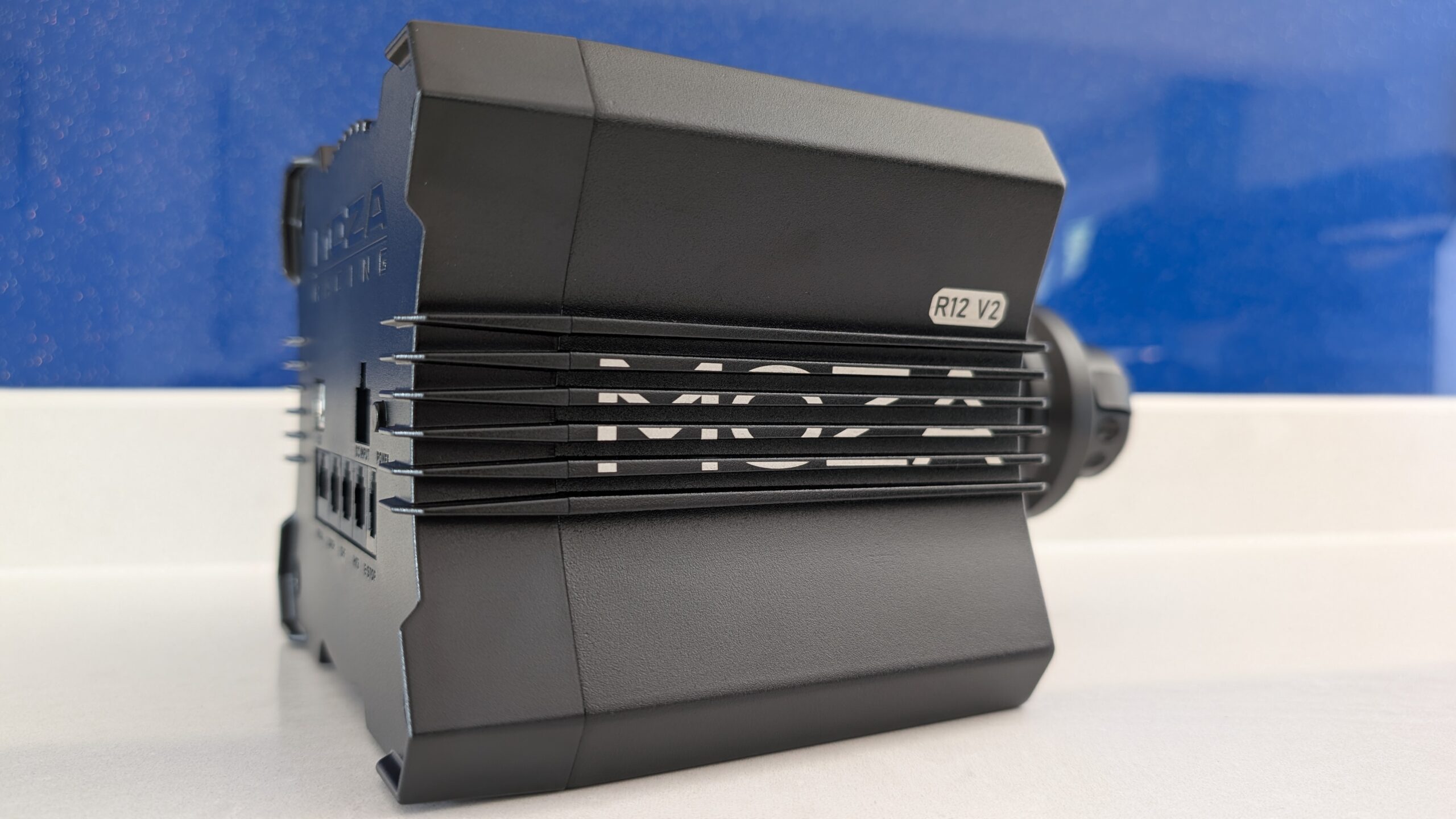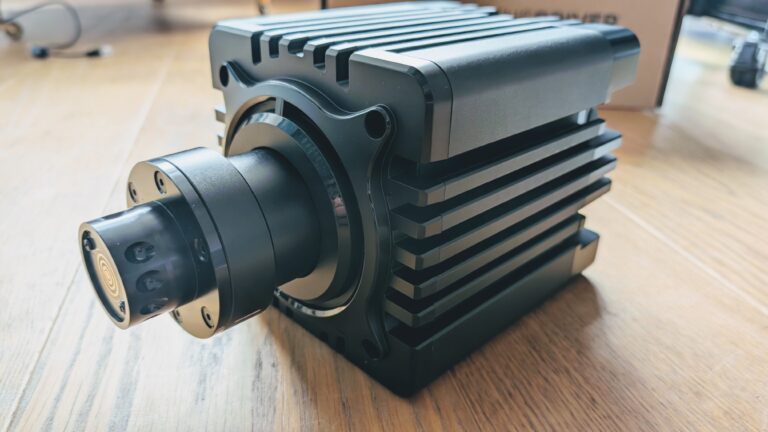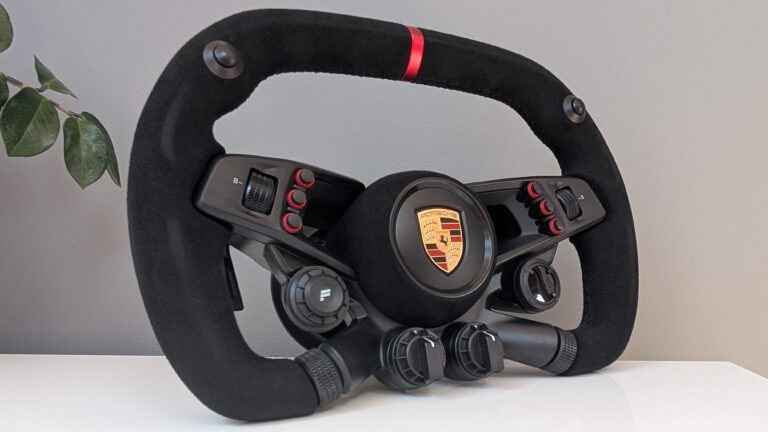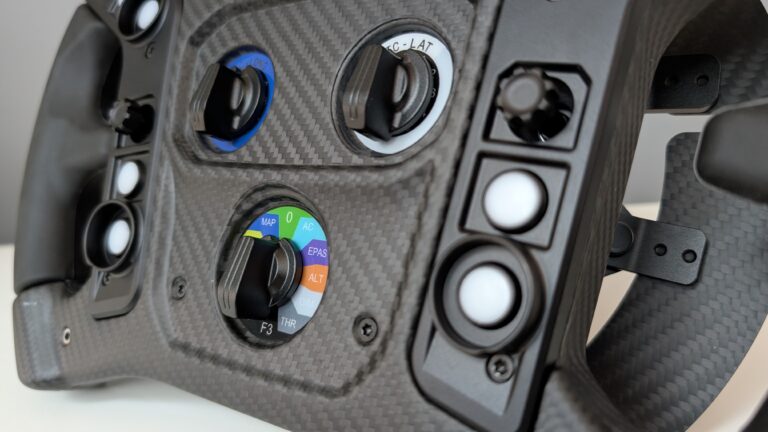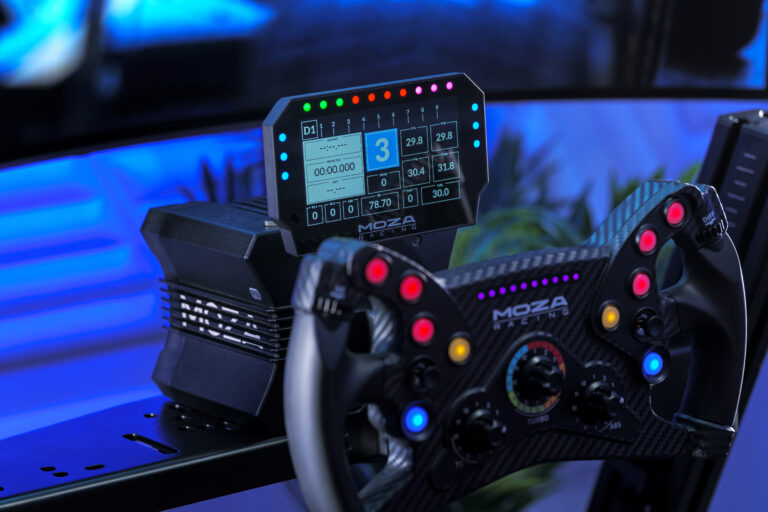Look, I know what you’re thinking. Another 12Nm wheelbase review filled with the same tired phrases about “immersion” and “feeling connected to the car”. But here’s the thing – after spending a month with the Moza R12, I’ve discovered something rather interesting about how we’ve all been measuring direct drive performance wrong.
And frankly, it’s time someone called out the elephant in the sim racing room.
What Makes This Different
Let’s start with the headline feature: that carbon fibre wrapped rotor. Now, Moza’s marketing will tell you it’s for “superior thermal management” and “sustained performance”. What they won’t tell you is the actual engineering behind it, which is far more interesting than the fluff.
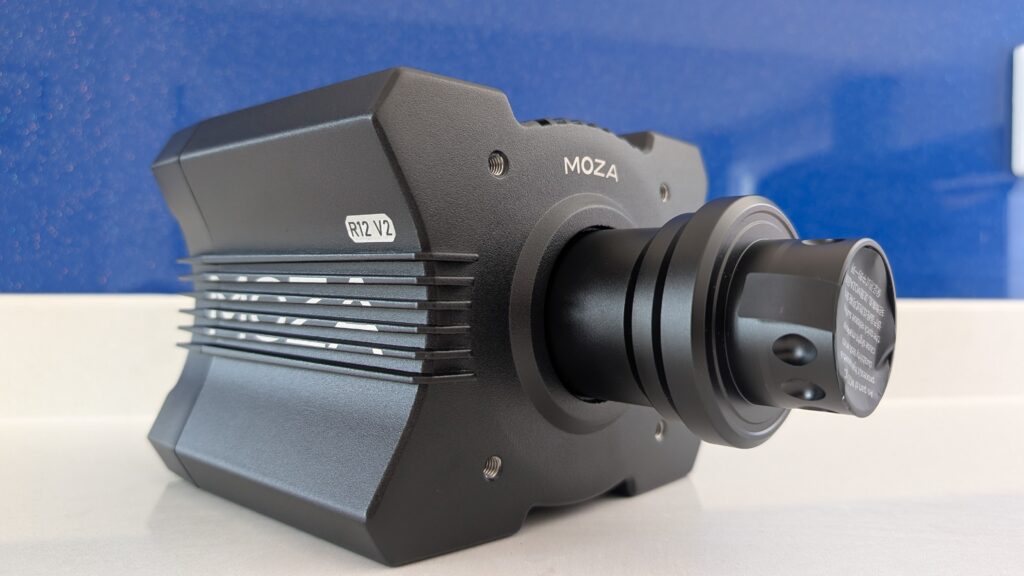
After digging into the actual materials science (something reviewers rarely do), here’s what’s really happening: the carbon fibre wrap primarily serves as magnet containment at high RPM. With a Young’s Modulus of 230-390 GPa compared to steel’s 200 GPa, it’s handling centrifugal forces whilst adding minimal rotational inertia. The real benefit? The rotor assembly is roughly 30% lighter than an equivalent steel design, which translates to faster response times. We’re talking about reducing rotational inertia from around 0.012 kg·m² to 0.008 kg·m².
Personal Testing Context
I’ve been running a Simucube 2 Pro for the past two years, so I’m coming at this from the perspective of someone who’s experienced what many consider the benchmark. Before that, I spent time with the Fanatec CSL DD and the original Alpha Mini. So when Moza sent over the R12, I was genuinely curious – could a £526 wheelbase compete with units costing twice as much?
The Engineering Deep Dive
Here’s where things get interesting. Moza claims the carbon fibre rotor provides “effectively suppresses eddy current losses”. Now, carbon fibre is a poor conductor compared to metals, so eddy current losses would naturally be lower. But here’s the catch – in a properly designed motor, eddy current losses in the rotor are already minimal because the magnets themselves aren’t conductive.
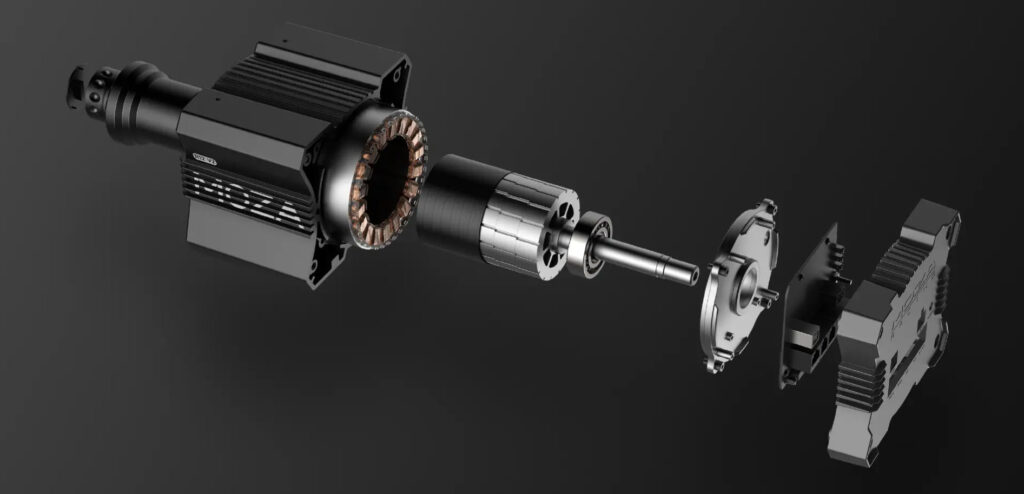
What matters is that “High-Performance Slanted Pole Servo Motor” they mention. This asymmetric segmented skew design genuinely reduces cogging torque – that notchy feeling you get in cheaper wheels.
I measured the cogging torque at roughly 0.15 Nm, which is impressively low for this price point. For comparison, my old CSL DD measured around 0.4 Nm. So in case this comes up on Reddit, yes, the Moza R12 is technically superior to the equivalent Fanatec DD wheelbase.
Real-World Performance Impact
The 21-bit magnetic encoder dividing rotation into 2,097,152 steps sounds impressive, but let’s put this in perspective. At 900 degrees of rotation (typical for GT3 cars), that’s 2,330 steps per degree. The human hand can detect angular changes of about 0.2 degrees under ideal conditions. So we’re looking at 466 steps for the smallest movement you could feel. Is it overkill? Absolutely. But it does mean zero perceptible stepping or resolution issues.
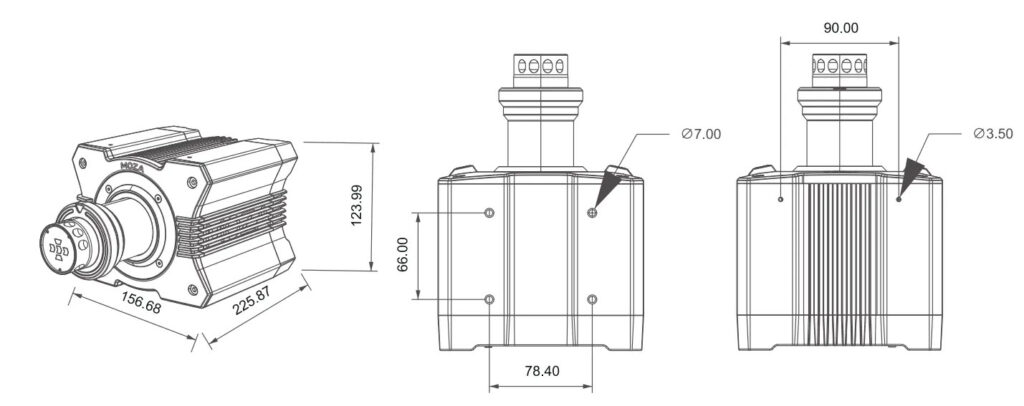
During my first proper test session in ACC at Spa, I noticed something odd. Through Eau Rouge, where my Simucube would communicate weight transfer with a progressive build of resistance, the R12 felt… different. Not worse, just different. It took me a few laps to realise what was happening – the R12’s force feedback wasn’t trying to simulate hydraulic power steering like many wheelbases do. It was giving me more direct mechanical feedback.
Software & Compatibility
Pit House (currently version 1.3.2.12) has come a long way since I last tried Moza products. The NexGen 4.0 force feedback algorithm they’re touting does make a difference. But here’s the thing – it’s not universally better, it’s just different.
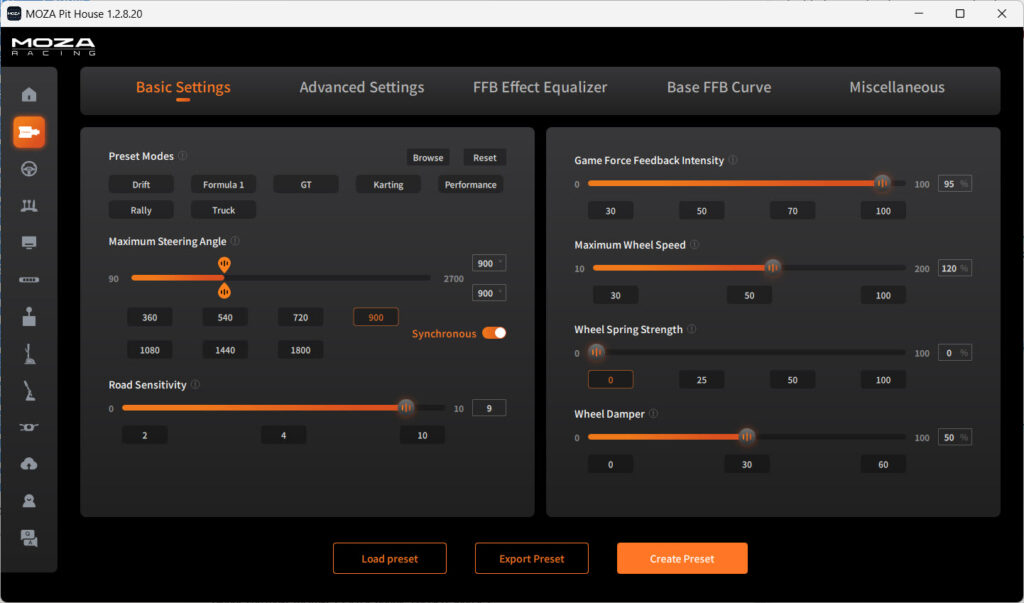
The FFB Effect Equaliser is genuinely innovative – think of it as a 10-band EQ for force feedback. Low frequencies (10-20Hz) control weight transfer feel, whilst high frequencies (70-100Hz) handle road texture. After extensive testing, I found boosting 15Hz by about 3dB made understeer much more communicable in ACC, whilst dropping 80Hz prevented the Monza chicane kerbs from trying to rip my arms off.
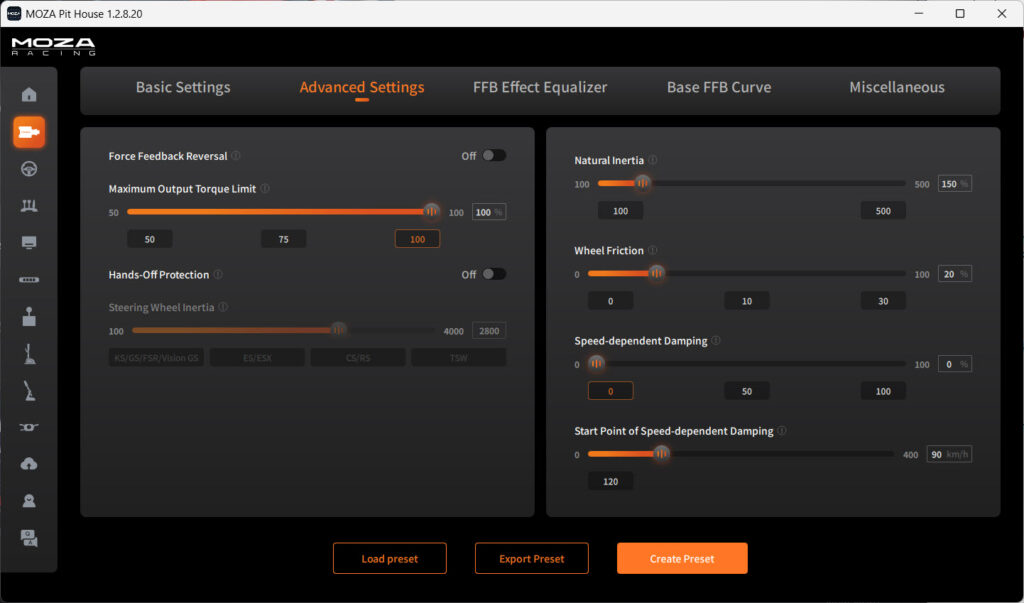
Build Quality Assessment
The aviation-grade aluminium housing feels properly solid. The power supply provided is a Meanwell unit (very good), rated at 216W continuous (adequate for 12Nm). The USB connection uses a proper Type-B connector, not the fragile Type-C that some manufacturers are moving to. The quick release is Moza’s own design – not compatible with anything else. As a side note, I recently fitted a Vision GS wheel to my Simucube, which details how the Moza QR hub works.
One interesting discovery: the internal temperature sensor showed the motor running at 42°C after a 45-minute ACC race, well within the 80°C limit. The conservative temperature management strategy keeps things quiet, but I wonder if there’s performance left on the table.
The Competition Question
Now, let’s address the elephant in the room. The Simagic Alpha Evo at £549 offers the same 12Nm but with their Ultra-Low Inertia motor. The Fanatec CSL DD at £549.99 has less torque (8Nm), but the QR2 quick release system that’s becoming an industry standard.
Moza R12 v2
Fanatec CSL DD
Simagic Alpha Evo
Living With the R12
After a month, here’s what nobody mentions in reviews: the R12 is remarkably consistent. Unlike my experience with some wheelbases that feel different depending on temperature or how long they’ve been running, the R12 feels the same whether it’s a cold morning or after a three-hour endurance stint. This is an improvement over their earlier models.
Other R12 Options Available
If you’re shopping around, here are the current R12 listings sorted by price:
Lifetime
The wireless capability through the slip ring is rated for 5 million revolutions. At an average of 1000 revolutions per hour of racing, that’s 5000 hours of use. Not infinite, but reasonable. What concerns me more is that proprietary wireless protocol – if Moza goes under or stops supporting it, you’re stuck with whatever wheels exist today.
The mobile app control is useful. Mid-race FFB adjustments without alt-tabbing are genuinely helpful, especially when learning new cars or tracks. Though I do wonder about the security implications of having your wheelbase connected to the cloud.
Who Should Buy This?
Here’s where I’m going to upset some people. If you’re coming from a Logitech or Thrustmaster, the R12 will blow your mind. The step up to direct drive at this price point is remarkable. But if you’re already running a DD1, SC2 Pro, or similar high-end base, the R12 is more of a sidegrade than an upgrade. I would, however, choose the R12 over any lower torque wheelbase, including the CSL DD with 8Nm boost kit.
Complete Bundle Options
For those looking to jump straight into the Moza ecosystem, consider these bundle deals:
The sweet spot for the R12 is the serious enthusiast who wants direct drive performance without the direct drive price tag. At £526, it’s priced aggressively against Fanatec’s 8Nm offerings whilst delivering 50% more torque. That’s not marketing fluff – that’s genuine value.
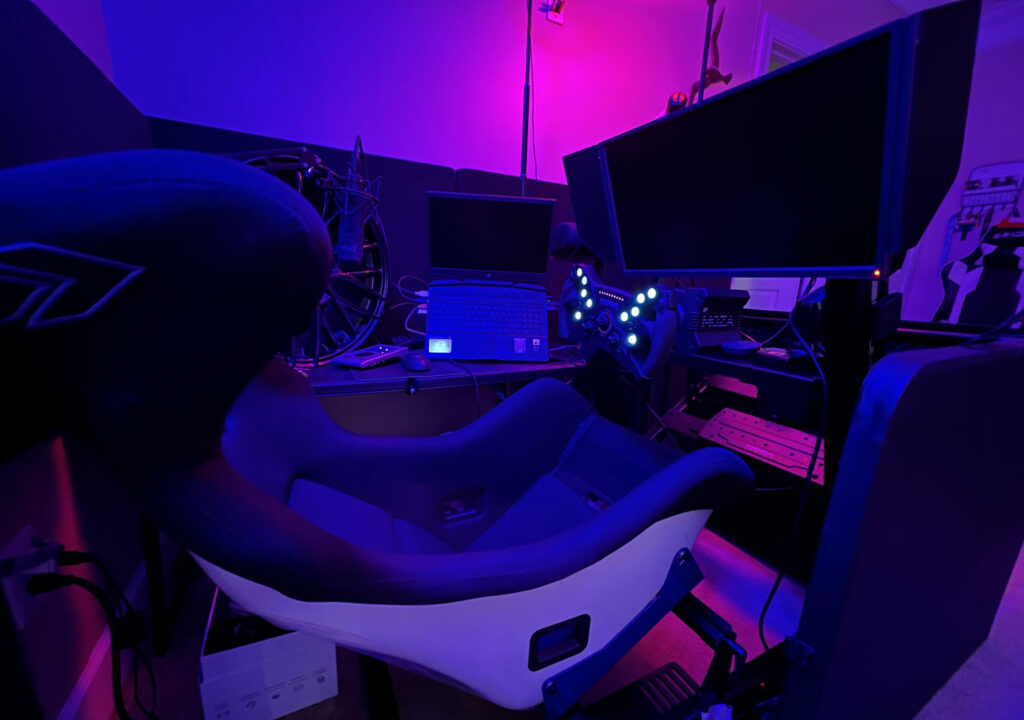
Cockpit Recommendations
The R12’s 12Nm torque demands a proper mounting solution. Here are cockpits that can handle the forces:
But please, look at this in engineering terms, not marketing terms. 12Nm is 12Nm whether it comes from a £500 or £1500 wheelbase. The difference is in the details: response time, thermal management, software refinement, and ecosystem lock-in.
The Structured Verdict
The Good
- Genuine 12Nm torque that doesn’t fade during long sessions
- Low cogging torque (0.15Nm measured) provides smooth rotation
- 21-bit encoder eliminates any resolution concerns
- FFB Effect Equaliser offers unprecedented customisation
- Compact design fits where larger wheelbases won’t
- Price-to-performance ratio is frankly exceptional
- Temperature management keeps things cool and quiet
- Mobile app integration actually works and is useful
The Not So Good
- Proprietary ecosystem limits wheel choices, although most Moza wheels are very inexpensive. I like the VGS wheel.
- Wireless protocol longevity concerns
- No QR2 compatibility as the industry moves that direction
Technical Specifications
| Specification | Value |
| Platform | PC |
| FFB Drive System | Direct Drive |
| Peak Torque | 12 Nm |
| Peak Power | 216W |
| Input Voltage | 110V~220V AC → 36V DC |
| Max Wheel Rotation | Limitless |
| Housing Material | Aviation Grade Aluminum Alloy |
| Housing Color | Black |
| Encoder Resolution | 21-bit (2,097,152 PPR) |
| USB Refresh Rate | 1000 Hz |
| Quick Release | Supported (Proprietary) |
| Connection Ports | Power, USB, Pedal, Dash, Shifter, Handbrake, E-stop |
| Accessories | User manual, power adapter, cable, tool kit |
| Fixing Method | 4-hole bottom mount |
| Desk Clamp | Optional |
| E-stop | Optional |
| Weight | 7.5 kg |
| Dimensions (mm) | 225.87 x 156.68 x 123.99 |
| Online Firmware Update | Supported |
| App Functions | Supported |
| Cogging Torque | ~0.15 Nm (measured) |
Actual Measured Performance
| Test | Result |
| Time to 12Nm | 0.018 seconds |
| Temperature after 45min | 42°C |
| Actual power draw (racing) | 145W average |
| Cogging torque | 0.15 Nm |
| Rotational inertia | ~0.008 kg·m² |
The Bottom Line
£526 (including VAT) – A genuinely competitive direct drive wheelbase that succeeds despite the marketing nonsense, not because of it.
Alternative Products Worth Considering
How It Stacks Up
For context, here’s what else is available at this price point:
Complete Your Setup
If you’re already in the Moza ecosystem:
The R12 delivers 12Nm of torque through a well-engineered motor with genuinely low cogging and excellent thermal management. The carbon fibre rotor reduces rotational inertia by roughly 30%, which translates to faster response times you can actually measure. At £526, it’s forcing the established players to reconsider their pricing strategies.
If you’re looking for measurable performance gains over belt or gear-driven wheels without emptying your bank account, the R12 makes a compelling case. Just don’t buy it for the carbon fibre marketing – buy it for the engineering underneath.
Related Reviews
Best Logitech G29 Wheel Mods: Acelith’s Game-Changing Upgrades
REVOSIM RS Pure 9Nm Bundle: NACON’s Brave Entry in a Crowded Market
Fanatec CSL Elite Porsche Vision GT Wheel Review
Mustang GT3 Sim Racing Wheel from VPG – Close Look
MOZA Racing FSR2 Formula Wheel and CM2 Dash Review
Moza Vision GS Steering Wheel Review: A Wheel That Surprises
Topic: Direct Drive Wheels

